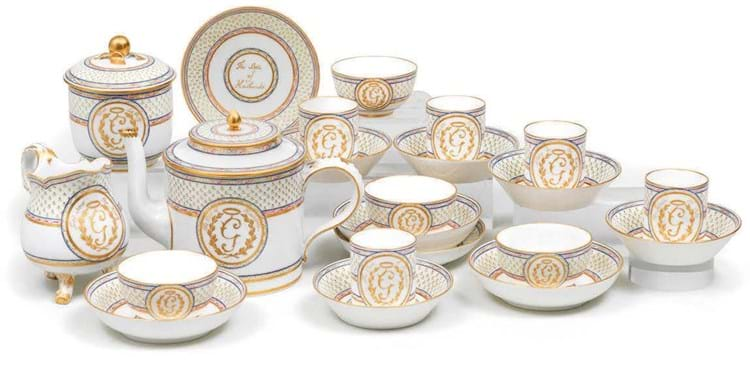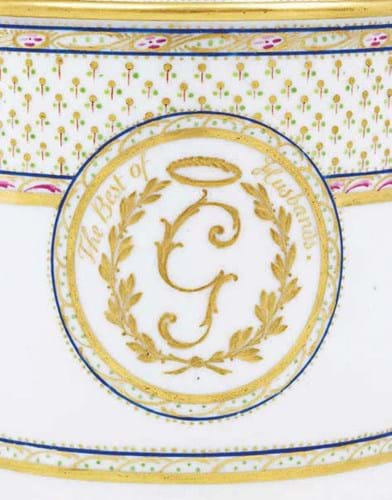
Sèvres part tea service made to mark the recovery of George III from illness in 1789 – £55,000 at Bonhams.
Estimated at £60,000-80,000, it sold at £55,000 (plus 27.5/25% buyer’s premium).
The 24 pieces of hard-paste porcelain offered at Bonhams’ July 7 sale titled 500 Years of European Ceramics were part of a larger service that was commissioned by the Spanish ambassador, the Marquis del Campo, for a gala held in the name of the King of Spain on June 9, 1789, to celebrate the king’s recovery.
Queen Charlotte, accompanied by her daughters, was the guest of honour at the event at Ranelagh Gardens, Chelsea.
The full service corresponds with one purchased from the Sèvres factory by the marchand-mercier Dominique Daguerre that is listed in the sales ledger between April 17 and August 12, 1789.

Each piece from the service sold at Bonhams is gilded with the royal cypher and inscribed with a motto, this one reading The Best of Husbands.
Each piece is gilded with the royal cypher and inscribed with one of several mottos reading The Best of Husbands, God Save the King, Viva Le Roy, Glory to the King, The Patron of Arts or The Best of Good Men.
Although differing accounts exist of how the Marquis del Campo disposed of the service after the gala, Elizabeth, Countess of Harcourt recorded in her memoirs that much of it was presented to her and her husband in February 1796, following his appointment as ambassador to the French Republic.
Royal possession
Most of the known pieces are now in the Royal Collection.
Elements of the tea service were purchased by Queen Mary in 1934 with the bulk of a dessert service remaining in the possession of the Harcourt family until 2003 when it was purchased by the current queen.
According to tradition the pieces offered at Bonhams – comprising a teapot, cover sugar, milk jug, nine cups and 10 saucers – came by descent from Mary, Duchess of Gloucester (1776- 1857) and then to Prince George, Duke of Cambridge (1819-1904).
In the later part of his life George III had recurrent and eventually permanent mental illness. When his health deteriorated significantly in the summer of 1788, doctors were largely at a loss to explain his illness, although it is thought today his acute mania was possibly a symptom of the genetic blood disease porphyria or bi-polar disorder.
In February 1789, the Regency Bill, authorising the Prince of Wales to act in the king’s place, was introduced and passed in the House of Commons.
However, before the House of Lords could pass the bill, George III had recovered. A series of patriotic commemorative objects, including medals and pendants, were made to mark his recovery (which coincided with the revolution in France).














